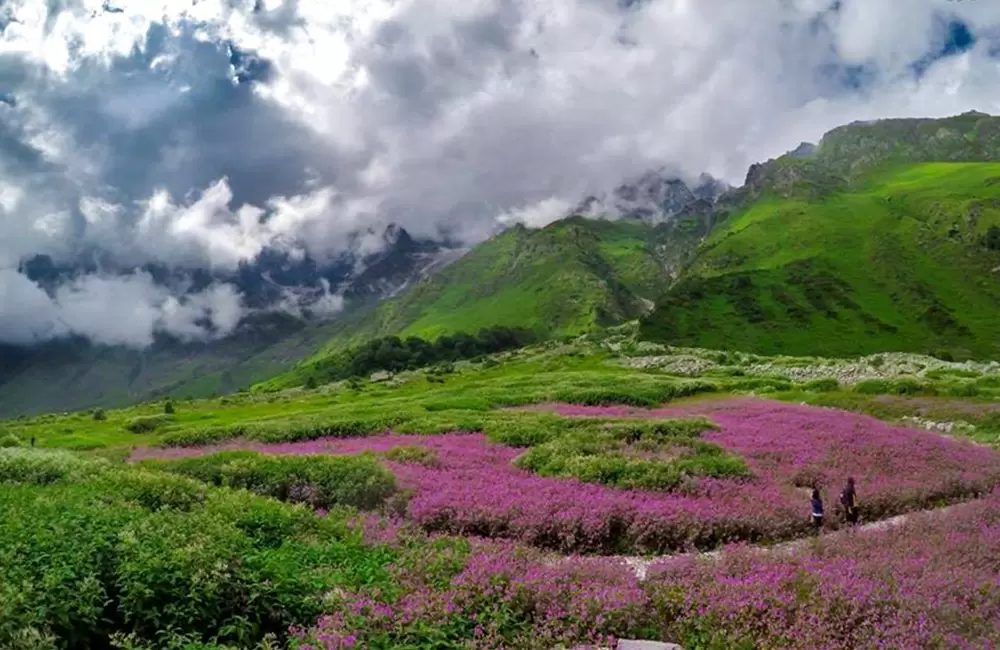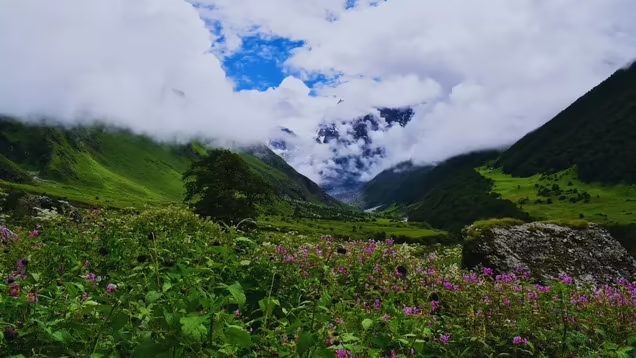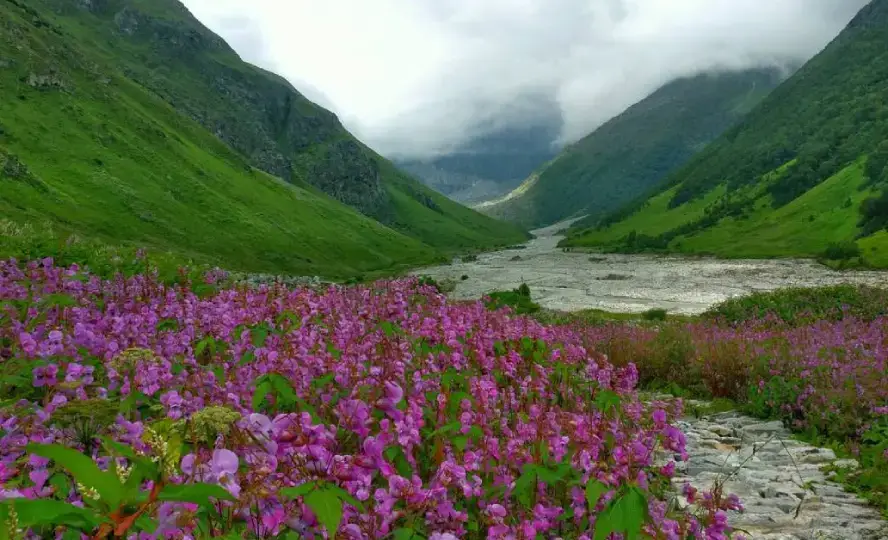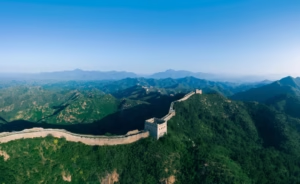Valley of Flowers: A Natural Paradise in the Himalayas
Nestled high in the Western Himalayas, the Valley of Flowers is a breathtaking national park known for its vibrant meadows of alpine flowers and rich biodiversity. Recognized as a UNESCO World Heritage Site, this enchanting valley attracts nature lovers, botanists, trekkers, and photographers from all over the world. Let’s explore the geography, climate, floral diversity, and the rich history of this natural wonder.

1. Location and Geography
The Valley of Flowers is located in the Chamoli district of Uttarakhand, in northern India. It lies within the Nanda Devi Biosphere Reserve, which includes the core areas of the Nanda Devi National Park and Valley of Flowers National Park.
- Coordinates: Latitude 30.728°N, Longitude 79.605°E
- Altitude: Ranges from 3,200 meters (10,500 ft) to 6,675 meters (21,900 ft) above sea level
- Total Area: Around 87.5 square kilometers
The valley is approximately 20 kilometers long and 5 kilometers wide, surrounded by snow-capped peaks like Rataban, Gauri Parbat, and Nilgiri Parbat. A glacial stream called Pushpawati River flows through the valley, adding to its scenic charm.
2. Climate and Best Time to Visit
The climate of the Valley of Flowers is typical of high-altitude Himalayan regions. The area remains covered in snow for most of the year and is accessible only during a short summer season.
Climate Overview:
- Summer (June to October):
- Temperature ranges from 5°C to 20°C
- Mild and pleasant during the day, cold at night
- The valley bursts into bloom during this period
- Winter (November to May):
- Extremely cold, with heavy snowfall
- The valley is inaccessible and closed to tourists
Best Time to Visit:
- Mid-July to Mid-August is considered the peak flowering season.
- The monsoon rains help the flowers to bloom in their full glory, turning the valley into a colorful carpet.
3. A Kaleidoscope of Flowers
The Valley of Flowers is world-famous for its diverse range of endemic flora. Over 600 species of flowering plants have been documented here. The lush meadows bloom with countless varieties of flowers, herbs, and shrubs during the monsoon season.
Commonly Found Flowers:
- Blue Poppy (Meconopsis aculeata) – The state flower of Uttarakhand
- Brahma Kamal (Saussurea obvallata) – A rare and sacred flower
- Himalayan Bellflower
- Anemone
- Primula
- Marsh Marigold
- Daisies
- Asters
- Forget-me-not
- Cobra Lily
Each week of the blooming season brings a different set of flowers, making every visit a unique experience.

4. Rich Biodiversity
Flora:
Apart from flowering plants, the valley is also home to a wide variety of ferns, mosses, lichens, and alpine shrubs. Due to its remoteness and high elevation, many of these plant species are medicinal and rare.
Fauna:
Although the valley is more famous for its flowers, it also supports a rich variety of animal life, including several endangered species.
- Snow Leopard (rare sightings)
- Himalayan Musk Deer
- Asiatic Black Bear
- Red Fox
- Blue Sheep (Bharal)
- Himalayan Tahr
Birds and Insects:
- Himalayan Monal (state bird of Uttarakhand)
- Snow Partridge
- Golden Eagle
- Various butterflies and bees, which aid in pollination
https://sypertimes.com/shimla-the-queen-of-hills-history-and-geography/
5. History and Discovery
The Valley of Flowers remained largely unknown to the outside world until the 20th century.
Discovery by Westerners:
In 1931, Frank S. Smythe, a British mountaineer and botanist, along with R.L. Holdsworth, accidentally stumbled upon the valley while returning from an expedition to Mount Kamet. Enchanted by its beauty, Smythe named it the “Valley of Flowers” and wrote a book of the same title, which brought global attention to the area.
Cultural and Religious Significance:
- The valley has long been considered sacred by the local Bhotiya people, who believe it to be inhabited by fairies and divine spirits.
- Nearby is Hemkund Sahib, a revered Sikh pilgrimage site, which also adds spiritual value to the region.
6. UNESCO World Heritage Site
In 1982, the Indian government declared the Valley of Flowers a national park to protect its unique ecosystem. In 2005, UNESCO designated it as a World Heritage Site, recognizing its outstanding natural beauty and ecological importance.
Conservation Efforts:
- Strict regulations are in place to limit human interference.
- No overnight stays are allowed within the valley.
- Plastic and littering are strictly prohibited.
- Entry is permitted only for a limited number of visitors per day to minimize environmental impact.
7. Trekking to the Valley
How to Reach:
- Nearest Airport: Jolly Grant Airport, Dehradun (approx. 300 km)
- Nearest Railhead: Rishikesh or Haridwar
- By Road: Travel up to Govindghat via Joshimath. From Govindghat, one must trek about 13 km to reach Ghangaria, the base camp for both Valley of Flowers and Hemkund Sahib.
- Final Trek: A 4 km trek from Ghangaria leads to the entrance of the Valley of Flowers.
Trek Difficulty:
- The trek is moderately challenging, suitable for fit individuals.
- The trail passes through scenic landscapes, waterfalls, and lush forests.
- Proper preparation, acclimatization, and trekking gear are recommended due to the altitude and changing weather.

8. Challenges and Environmental Concerns
Despite being a protected site, the Valley of Flowers faces several environmental challenges:
- Climate Change: Rising temperatures may alter flowering patterns and threaten sensitive alpine species.
- Tourism Pressure: Though regulated, increasing footfall during the peak season can disturb local flora and fauna.
- Landslides and Flooding: The region is prone to natural disasters during the monsoon, making accessibility risky.
Conservationists and the local government continue to work on sustainable tourism and protection programs.
9. Valley of Flowers vs. Other Flower Valleys
The Valley of Flowers is often compared to other floral destinations like Kaas Plateau in Maharashtra or Tulip Gardens in Kashmir, but it stands out due to its high-altitude setting, alpine biodiversity, and pristine environment.
What Makes It Unique:
- Rare Himalayan flora found nowhere else
- A blend of natural beauty and spirituality
- UNESCO World Heritage recognition
- Remote, untouched by commercial tourism
10. Conclusion
The Valley of Flowers is more than just a visual spectacle—it’s a symbol of nature’s delicate balance and resilience. Whether you’re a botanist searching for rare plants, a trekker seeking adventure, or a soul in search of peace, the valley offers something profound.
Its colorful landscapes, serene environment, and mystical legends make it one of the most cherished treasures of India. Protecting it is not just the responsibility of the government, but also of every visitor who steps into this living paradise.
Quick Facts Recap:
| Feature | Details |
|---|---|
| Location | Chamoli, Uttarakhand, India |
| Altitude | 3,200 m to 6,675 m |
| Best Visit Time | July to August |
| Famous Flowers | Blue Poppy, Brahma Kamal, Primula |
| Nearby Sites | Hemkund Sahib, Joshimath |
| Accessibility | Trek from Govindghat via Ghangaria |
| UNESCO Status | Since 2005 |




